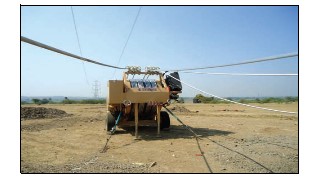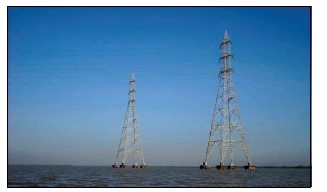 — Lalit Jalan, CEO & Whole-time Director,
Reliance Infrastructure Ltd
— Lalit Jalan, CEO & Whole-time Director,
Reliance Infrastructure Ltd
Part of the
Anil Dhirubhai Ambani Group, Reliance Infrastructure
Ltd is India's leading utility company with a turnover of over

15,000 crore. It has a formidable presence across major highgrowth
sectors like highways, power, metro rail, airports and
speciality real estate. In the power sector, RInfra spans all
aspects—generation, transmission, distribution, EPC contracting
and trading. RInfra needs special mention for its deep involvement
in PPP-based infrastructure projects.
Lalit Jalan, who oversees all
the business verticals of RInfra, speaks at length about its power
transmission business. An interview by
Venugopal Pillai.
Reliance Infrastructure became India's first developer of a power
transmission line awarded on tariff-based competitive bidding
when it clinched WRSSS-II. Tell us more on this project and its
current status.
WRSSS-II (Western Region System Strengthening Scheme) was
split into four packages of which two packages (A & D) are being
developed by Power Grid Corporation of India, while Packages B
and C were offered on tariff-based competitive bidding, which were
awarded to RInfra. This is the country's first ever 100 per cent
privately owned transmission project that executes inter-state
lines, which are elements of the National Grid.
WRSSS-II projects, being developed by RInfra on BOO basis,
consist of nine 400kV transmission lines, spanning 1,500 km across
Maharashtra, Gujarat and Madhya Pradesh. RInfra has already
commissioned three lines, which have started earning revenues.
Another two lines are expected to be commissioned shortly, which
would add to the revenues. The remaining four lines are scheduled
for commissioning in FY2012.
How are the two ultra mega power transmission projects awarded
to Reliance Infrastructure (North Karanpura and Talcher-II)
progressing? Could you elaborate on RInfra invoking the "force
majeure" clause on the two projects?
The special purpose vehicles (SPV) created for these projects
have already been transferred to RInfra in April/May 2010 and
financial closure was also achieved in September/October
2010. However, enabling clearance to start project construction
under Section 164 of Electricity Act 2003 is yet to be received
from the Government of India. As a result of this delay, which is
beyond our control, we have sent out notices invoking "force
majeure" clause to the beneficiaries and subsequently
approached the CERC for redressal, which is currently under
consideration of the Hon'ble Commission
India has plans to award a series of mega power transmission
projects using the tariff-based competitive bidding route on the
Case-2 model. What challenges do you see in this endeavour?
The Case-2 model is specific to power generation projects and not
to the transmission projects, which will be awarded on a tariffbased
competitive bidding. Government of India has notified five
transmission projects recently and two of these are already in
qualification stage. The key challenge will be to reduce the cycle
time from NIT to handover of SPV to the successful bidder, which is
currently taking a little bit longer.
How do you gauge India's success rate so far and how do you see
the PPP model unfold in the power transmission sector in the years
to come?
Till date eight projects in the Central Sector and six projects in
state sector by Rajasthan, UP and Haryana have been awarded
under tariff-based competitive bidding. Experimentation that
started with the WRSSS-II projects has been successful with
commissioning of first three lines by RInfra. From now on all
inter-state transmission projects but for a few exclusions shall be
awarded on tariff-based competitive bidding, open for private
participation. The state sector may follow suit in some time, meanwhile more states can be expected on the lines of Rajasthan,
Haryana and UP to opt for PPP model.
 Thanks to the "Open Access" policy, progressive states are now
allowing consumers to import power from other states. Do you see
this, coupled with upcoming IPP plants, spurring the demand for
inter-state transmission lines?
Thanks to the "Open Access" policy, progressive states are now
allowing consumers to import power from other states. Do you see
this, coupled with upcoming IPP plants, spurring the demand for
inter-state transmission lines?
This has already been the driving force for the planning at Central
and State sector. At current levels of ten percent of the power
generated in the country being traded, lots of such transactions
have been held up due to network congestion. This clearly indicates
increased need for faster augmentation of inter-state and intrastate
transmission network across the country.
Power transmission projects are by nature very land-centric and
can be bogged down by right of way and forest clearance issues.
How can India reduce procedural delay and hasten the
development of bulk power transmission corridors?
Transmission lines traverse through long distances and have to
cross agricultural lands, forests and industrial zones. While
implementing transmission lines, managing right of way is most
critical to complete to project in time. Many times issues like
handling law & order situation, obtaining clearances from multiple
governmental agencies pose as challenges. In the present
structure, private developer is compelled to handle all these risks
that beyond its direct control. For facilitation quick implementation
of transmission projects, it is essential to have a government
agency to facilitate managing right of way as is done by NHAI in
roads sector
Reliance Infrastructure had formed a joint venture with PGCIL for
setting up evacuation infrastructure for the Koldam and Parbati
projects. What is your view on PGCIL's philosophy in forming
minority JVs with private developers for power transmission
infrastructure?
Our JV, named Parbati Koldam Transmission Company Ltd, has
already achieved financial closure and obtained other critical
clearances. Construction contracts have been awarded and
construction has commenced. These JVs were formed under the
earlier guidelines where tariff fixation was possible through costplus
route. Under the current policy framework, any such JV
formed by PGCIL shall have to participate in tariff-based
competitive bidding for the projects put up for the same.
What is your general take on India's attempts to build UHVAC
1,200kV power transmission infrastructure?
A 1,200kV UHVAC transmission line is expected to carry about
6,000 to 8,000 mw of power. This is about 10 times that of a 400kV
line, which is the current backbone of Indian inter-state
transmission network. This technology has been under
development and testing.
States like Maharashtra, Gujarat and Haryana are building interstate
power transmission infrastructure through private
participation. What is RInfra's plan of bidding for intra-state lines?
RInfra has incorporated Reliance Power Transmission Ltd as a
subsidiary focused on such business opportunities. Based on the
size and other factors, we have been participating and are open to
participate in all models.
 Very briefly, how would you rate India's overall success in terms of
private participation in power transmission? What has been India's
biggest achievement at the policy level?
Very briefly, how would you rate India's overall success in terms of
private participation in power transmission? What has been India's
biggest achievement at the policy level?
The government of India has taken a long time since enactment of Electricity Act 2003 in evolving the enabling policy, regulatory and
contractual framework for private participation in transmission
business. In the Central sector, private participation has been
successfully experimented whereas the state sector is trying to
catch up. Major policy shift in central sector has been to move from
a monopolistic model of transmission development to a total
competitive model. Similar move in state sector is expected.
Can you suggest three policy recommendations to boost private
sector participation in India's power transmission sector?
I would say:
- Statutory and regulatory clearances essential to start project
construction should be made available prior to handing over of
the project to private developer
- Facilitation of obtaining RoW and Forest clearance by
Government
- Commodity Risk during construction period above a certain
threshold be made pass through
Please summarize RInfra's growth plans in the power transmission
sector for the next 5-7 years.
Future investment opportunity in transmission sector is currently
estimated to be in excess of

200,000 crore. RInfra's growth plan
is emanating from this investment opportunity. Presently RInfra
has five transmission projects with an outlay of about

7,000 crore
which the company is executing in full swing. In view of the ample
opportunities available, the company would continue to participate
in profitable opportunities in the sector.